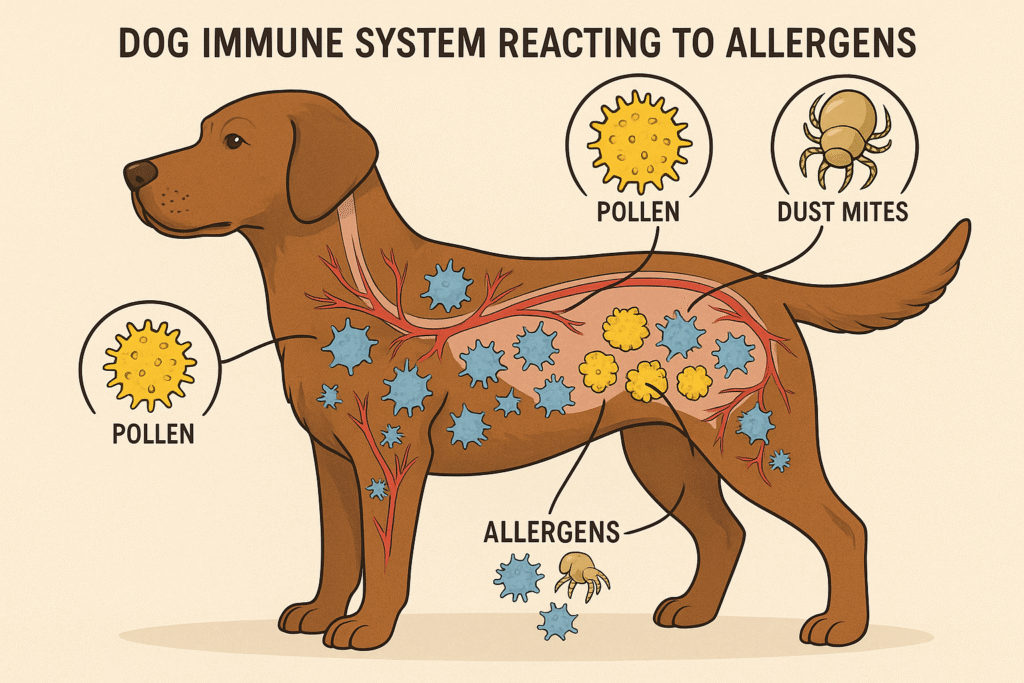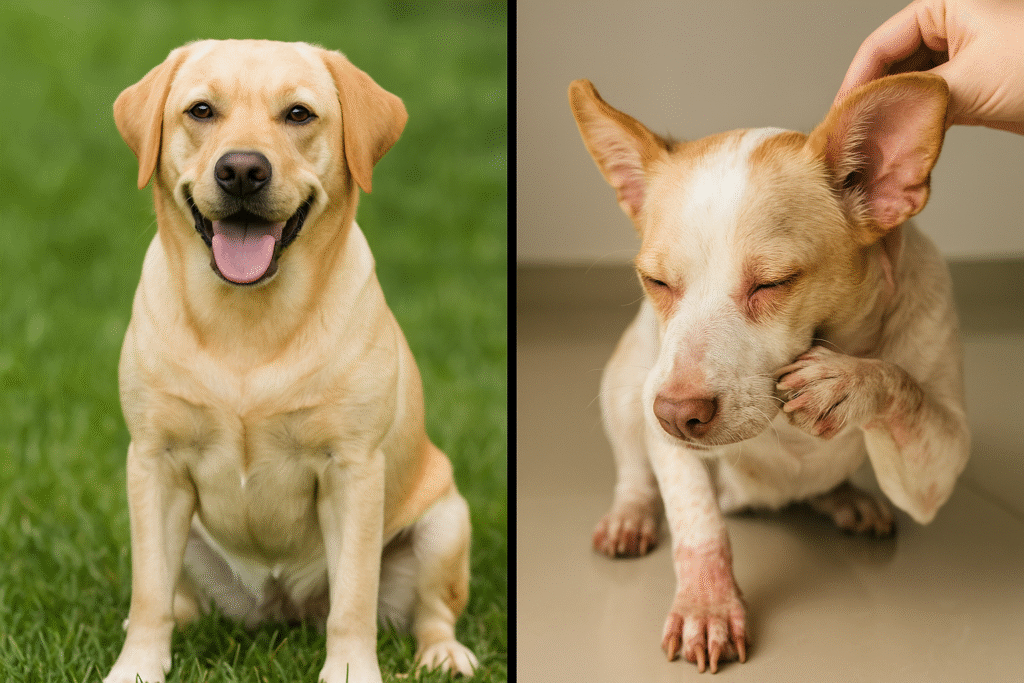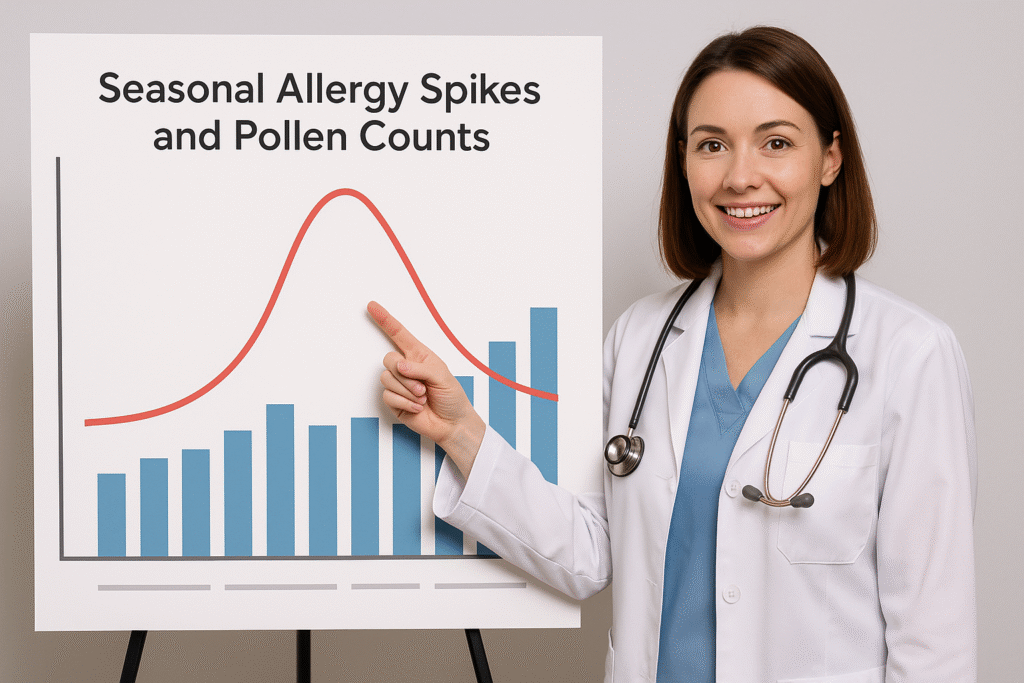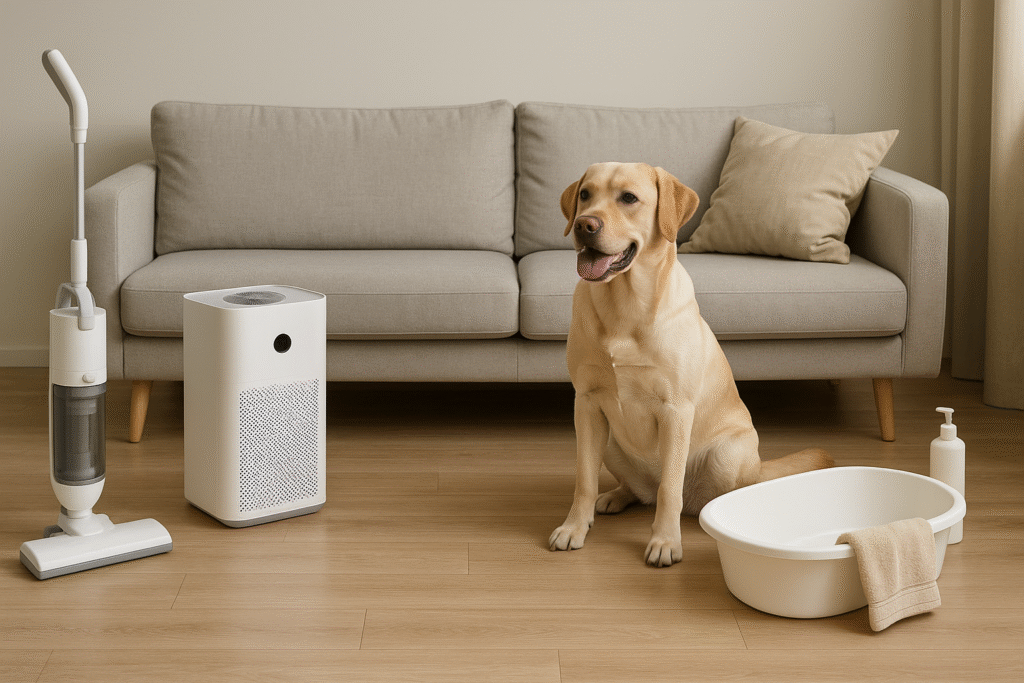Medical Disclaimer: This article is for informational purposes only and does not substitute for professional veterinary advice. Always consult your veterinarian before starting any treatment.
Table of Contents
If your dog starts itching more as the weather warms or sneezing every time you open the window, you’re not alone. Seasonal allergies in dogs are one of the most frustrating issues I see in practice especially during the spring and fall. As a Canadian vet, I’ve helped countless pet parents navigate months of scratching, licking, and red, irritated skin. The good news? You can catch the signs early and manage the condition effectively with the right tools and veterinary support.
This guide breaks down how to recognize seasonal allergies in dogs, understand the triggers behind them, and explore evidence-backed treatments so your pup can get back to enjoying the outdoors without the itch.
Key Takeaways: Seasonal Allergies in Dogs
- Seasonal allergies in dogs are typically triggered by environmental allergens like pollen, dust mites, and mould.
- Common symptoms include itching, ear infections, skin irritation, and chewing on paws.
- Diagnosis involves ruling out other causes (e.g., fleas, food allergies) and may include allergy testing to guide treatment.
- Treatments range from fast-acting anti-itch medications like Apoquel and Cytopoint to long-term immunotherapy.
- Consistent environmental management, topical care, and nutritional support can significantly reduce flare-ups.
- Dogs may need year-round care if exposed to indoor allergens like dust or mould.
- Partnering with your veterinarian ensures a customized, sustainable plan for managing your dog’s seasonal allergies.
What Are Seasonal Allergies in Dogs?
you can Also visit: https://doglifeexpert.com/best-traditional-chinese-medicine-for-dogs/

Seasonal allergies in dogs medically referred to as canine atopic dermatitis occur when a dog’s immune system overreacts to typically harmless environmental substances. These allergens can include:
- Tree, grass, or weed pollen
- Dust mites
- Mould spores
- Animal dander
- Indoor allergens like cleaning sprays or scented candles
Despite the name, seasonal allergies in dogs aren’t always strictly seasonal. Many dogs react to indoor allergens that are present all year round. In fact, studies like those summarized in PetMD emphasize that some cases initially thought to be seasonal become chronic due to cumulative triggers.
Breed Predisposition
Certain breeds are genetically predisposed to developing seasonal allergies in dogs. These include:
- Golden Retrievers
- Labrador Retrievers
- West Highland White Terriers
- Bulldogs
- Shar-Peis
- Boxers
- German Shepherds
Dogs typically begin showing symptoms between 6 months and 3 years of age. If you notice recurring skin problems or itching that seems to flare with the seasons, seasonal allergies in dogs could be to blame.
According to Dr. Julie Buzby, the condition tends to worsen with age and often requires lifelong management.
How to Spot Seasonal Allergies in Dogs

Recognizing the symptoms of seasonal allergies in dogs early can prevent long-term skin damage and reduce the need for aggressive medications.
Common Signs of Canine Atopic Dermatitis
Detailed Symptoms of Seasonal Allergies in Dogs
1. Persistent Itching (Pruritus)
The hallmark sign of seasonal allergies in dogs is intense, often relentless itching. It tends to localize around the:
- Paws: dogs may constantly lick or chew at their feet, sometimes until the skin is raw or stained brown from saliva.
- Face and muzzle: rubbing against furniture or carpeting is common.
- Underarms, belly, and groin: these warm, moist areas are especially vulnerable to inflammation and secondary infections.
This itching is triggered by the immune system’s overreaction to environmental allergens like pollen or dust mites.
2. Excessive Licking or Chewing
Dogs may compulsively lick their paws, legs, or flanks to relieve itching. Chewing or nibbling can create moist, irritated patches prone to bacterial or yeast infections. Over time, this self-trauma worsens inflammation, turning a mild allergy into a painful skin condition.
3. Red or Inflamed Skin
Inflamed areas may appear:
- Bright red or pink in light-skinned dogs
- Dark brown, purple, or blackened in dogs with chronic changes
- Thickened and leathery with long-term exposure (lichenification)
The belly, underarms, and inside of the thighs are particularly prone to inflammation in dogs with seasonal allergies.
4. Frequent Ear Infections
Recurring otitis externa is one of the most consistent signs of seasonal allergies in dogs. You might notice:
- Head shaking
- Scratching at the ears
- Foul odour
- Red, waxy, or pus-filled discharge
Allergic dogs often have increased cerumen production (ear wax), which creates an ideal environment for yeast and bacteria.
5. Hot Spots, Pustules, or Open Sores
Areas of intense itching can rapidly become:
- Hot spots (acute moist dermatitis): rapidly forming, painful, oozing lesions
- Pustules: small pus-filled bumps
- Crusted sores or scabs, especially on the neck, cheeks, or thighs
These are almost always a secondary complication caused by scratching and biting.
6. Odour or Greasy Skin
When seasonal allergies in dogs lead to chronic skin irritation, they often develop:
- Seborrhoea (greasy skin)
- A musty or sour odour due to yeast (Malassezia) overgrowth
- Flaky dandruff or excessive oil production
These changes are frequently overlooked but are key indicators of underlying allergies.
7. Reverse Sneezing, Watery Eyes, or Nasal Discharge
Though less common than skin symptoms, upper respiratory signs can appear in some dogs:
- Reverse sneezing: rapid, forceful inhalations that sound alarming but are generally harmless
- Tearing (epiphora): especially in brachycephalic breeds
- Clear nasal discharge or mild congestion during peak allergy seasons
These symptoms typically accompany environmental exposure such as high pollen days or dusty environments.
ICADA Guidelines & Diagnosis Criteria
The International Committee on Allergic Diseases of Animals (ICADA) outlines a methodical approach to diagnosing atopic dermatitis. According to Hensel et al. (2015), diagnosis involves:
- Excluding other conditions: such as flea allergy dermatitis, sarcoptic mange, food allergies, and infections.
- Applying Favrot’s Criteria: a set of clinical indicators that increase the likelihood of atopic dermatitis.
- Using intradermal testing (IDT) or allergen-specific IgE blood tests (ASIS) to guide treatment not for diagnosis alone.
A dog doesn’t need a positive allergy test to be diagnosed. Rather, testing helps determine which allergens to include in allergen-specific immunotherapy, which we’ll cover shortly.
Scientific Background: What the Research Shows

Understanding the science behind seasonal allergies in dogs helps us appreciate why they’re so persistent and complex.
Allergies and Environmental Data
A 2021 study published in the Veterinary Dermatology journal found a direct correlation between local pollen counts and flare-ups in allergic dogs (Wiley Online Library). Dogs exposed to high levels of tree or grass pollen in spring and summer showed a significant increase in itching, ear inflammation, and skin lesions.
In Canada, fluctuations in weather especially in humid regions like Ontario and British Columbia create an ideal environment for mould and pollen proliferation, making seasonal allergies in dogs particularly problematic in these zones.
Variability by Breed and Individual Response
While genetics play a role, not all dogs with a genetic predisposition will develop symptoms. Some may have mild reactions, while others require year-round medical management. Response to treatment varies widely as well.
Even within my own caseload, I’ve had two littermates both Golden Retrievers show vastly different responses: one managed well with antihistamines and wipes, the other required monthly Cytopoint and a strict immunotherapy regimen.
The Limitations of Allergy Testing
Despite being widely used, allergy tests are not infallible. According to PubMed research, intradermal and serum allergy testing can yield false negatives in up to 30% of cases. This means a dog may have clinical signs of seasonal allergies but still test negative.
That’s why veterinarians diagnose primarily through clinical history and symptom patterns then use testing to fine-tune treatment plans.
How to Treat & Manage Seasonal Allergies in Dogs

There is no permanent cure for seasonal allergies in dogs, but with the right combination of treatments, most dogs experience significant relief. The key is individualizing the plan with your vet based on symptom severity, budget, and lifestyle.
1. Fast-Acting Medications
- Apoquel (oclacitinib): An oral Janus kinase inhibitor that quickly relieves itching, often within 4 hours. Safe for long-term use in adult dogs (Dr. Buzby).
- Cytopoint (lokivetmab): An injectable monoclonal antibody that neutralizes IL-31, a key itch signal. Relief can last 4–8 weeks and is safe for most dogs over 1 year.
- Steroids (e.g., prednisone): Fast but best reserved for short-term rescue due to long-term side effects like weight gain, liver issues, and immune suppression.
These are often used during acute flares or seasonal peaks, then tapered once other therapies take effect.
2. Topical Care & Bathing
- Use medicated shampoos with chlorhexidine, ketoconazole, or phytosphingosine weekly.
- Wipe paws and bellies after walks to remove pollen or allergens.
- Try prescription sprays or mousses that support the skin barrier and reduce inflammation.
- Clean ears regularly with a pH-balanced veterinary cleanser to prevent otitis externa.
This approach reduces surface allergen load, which is crucial for managing seasonal allergies in dogs that manifest through skin contact.
3. Allergen-Specific Immunotherapy (ASIT)
Often considered the gold standard for long-term control, ASIT involves:
- Identifying key allergens via intradermal or serum testing.
- Administering tailored allergen extracts subcutaneously or orally over time.
- Most dogs see a 50–80% improvement within 6–12 months (BioMed Central).
Immunotherapy can reduce reliance on medications and is often the only long-term solution for moderate to severe cases of seasonal allergies in dogs.
4. OTC Antihistamines
While not effective for every dog, antihistamines can help in mild cases or when used preventatively:
- Cetirizine (Reactine)
- Loratadine (Claritin)
- Diphenhydramine (Benadryl)
- Hydroxyzine (prescription only)
Effectiveness varies widely, and they’re often more successful when given before peak allergy seasons. Always consult your veterinarian for correct dosing and to ensure they won’t interact with other medications. Keep in mind that seasonal allergies in dogs often require multimodal therapy, not just antihistamines.
5. Supplements & Nutritional Support
- Omega-3 fatty acids (EPA/DHA) help reduce inflammation and improve skin integrity.
- Probiotics and prebiotics can enhance gut health and modulate immune response.
- Colostrum and quercetin (natural antihistamines) may provide adjunctive support.
These aren’t cures, but they often enhance the effectiveness of prescription treatments when used consistently.
6. Environmental Control

One of the most overlooked yet essential steps in managing seasonal allergies in dogs:
- Use HEPA filters and air purifiers indoors.
- Vacuum frequently with allergen-rated machines.
- Bathe dogs after high-pollen days or hikes.
- Wash bedding weekly in hot water.
- Maintain year-round flea prevention, as flea saliva can worsen allergic responses.
A 360-degree approach treating the dog and the environment gives the best chance of success.
Real-World Strategies for Pet Parents

Successfully managing seasonal allergies in dogs isn’t just about medication. Daily routines, seasonal awareness, and good communication with your vet all play critical roles.
Start Early: Pre-Seasonal Prevention
- Begin medicated baths, supplements, and possibly antihistamines a few weeks before pollen season starts.
- Track environmental allergens in your region using apps or pollen forecast websites.
Log Flare Patterns
- Keep a symptom diary: note dates, symptoms, weather, and any new products used (e.g., cleaning sprays).
- Many dogs follow consistent seasonal cycles spring trees, summer grasses, fall weeds—and logs can help your vet tailor a proactive plan.
Build a Long-Term Plan With Your Vet
- Request regular re-evaluations every 6–12 months to adjust medications and monitor side effects.
- Consider rotating between Cytopoint and Apoquel during different seasons to reduce drug resistance or cost.
- If your dog also has food allergies, stick rigidly to prescription diet trials no table scraps, treats, or flavored meds during trials.
In practice, I’ve seen the best outcomes in dogs whose owners are consistent and attentive to flare-up cues. Managing seasonal allergies in dogs often becomes a lifelong project but one that’s entirely manageable with the right tools.
What We Still Don’t Fully Understand
Despite decades of research, seasonal allergies in dogs remain a complex puzzle. Several aspects still challenge both veterinarians and researchers.
Mixed Allergies: Food + Environmental

Many dogs show symptoms of both food and seasonal allergies simultaneously. These overlapping signs like itching, ear infections, and belly rashes make it difficult to distinguish between causes. The only reliable method is a strict elimination diet trial, often lasting 8–12 weeks.
Allergy Test Inaccuracy
According to studies like PubMed’s ICADA review, both intradermal and IgE-based allergy tests carry significant risks of false negatives and false positives. That’s why allergy testing should be used to customize immunotherapy not to confirm or rule out a diagnosis.
Breed-Specific Response Variability
Even among dogs with identical exposures and treatment protocols, responses vary. Some breeds (like Westies or Bulldogs) may need year-round management, while others respond beautifully to seasonal-only treatment.
The takeaway? Seasonal allergies in dogs require a flexible, evolving approach tailored to each patient’s genetic makeup, lifestyle, and environment.
Quick Summary Table
| Topic | Key Insights |
|---|---|
| Primary triggers | Pollen, dust mites, mould, dander |
| Most affected breeds | Golden Retrievers, Westies, Labs, Bulldogs, Shar-Peis |
| Common symptoms | Itching, licking paws, red skin, ear infections, reverse sneezing |
| Diagnostic approach | Rule out fleas/food; use Favrot’s Criteria; allergy tests guide immunotherapy |
| Core treatments | Apoquel, Cytopoint, steroids (short-term), antihistamines, immunotherapy |
| Supportive care | Medicated baths, omega-3s, probiotics, environmental control |
| Preventative steps | Pre-season treatment, symptom tracking, flea prevention, HEPA filters |
| Long-term outlook | Manageable with consistency; some cases need year-round therapy |
This table offers a practical reference for dog owners dealing with seasonal allergies in dogs, helping them spot patterns and initiate proactive care.
Frequently Asked Questions About Seasonal Allergies in Dogs
1. Can dogs really have seasonal allergies like humans?
Yes. Dogs develop allergic reactions to many of the same things as humans pollen, mould, and dust mites. However, instead of sneezing, seasonal allergies in dogs often cause skin issues like itching and infections.
2. How are seasonal allergies diagnosed in dogs?
Diagnosis is based on history, symptoms, and ruling out other conditions like fleas or food allergies. Allergy testing may help guide immunotherapy, but it’s not essential for diagnosis.
3. What’s the best treatment for my dog’s seasonal allergies?
There’s no one-size-fits-all answer. Most dogs respond well to a combination of Apoquel or Cytopoint, bathing routines, and long-term immunotherapy. Your vet will help customize the plan.
4. Are over-the-counter antihistamines safe for dogs?
Some are, but always check with your vet. Options like cetirizine or loratadine can help mild cases of seasonal allergies in dogs, but they’re rarely effective alone.
5. Can seasonal allergies in dogs be cured?
No permanent cure exists, but symptoms can be well controlled with consistent treatment and environmental management. Some dogs improve significantly over time, especially with immunotherapy.
6. Do allergies get worse with age?
Often, yes. Symptoms may become more persistent, and dogs can develop sensitivities to additional allergens as they age. Early intervention helps slow this progression.
Living with seasonal allergies in dogs often feels like running a marathon with no finish line itchy skin, midnight scratching, ear infections that just won’t quit, and repeat trips to the vet. Many pet owners tell me they feel helpless watching their dog suffer year after year. But here’s the truth: while we can’t cure these allergies, we can manage them. And we can do it well with the right tools, timing, and teamwork.
Over the years, I’ve helped countless dogs regain comfort and quality of life through a tailored, multi-pronged approach. For some, it’s as simple as starting antihistamines early and switching to a hypoallergenic shampoo. For others, especially those with moderate to severe seasonal allergies in dogs, long-term strategies like immunotherapy or prescription anti-itch medications are essential. The key is building a plan that fits your dog’s specific triggers and sticking to it consistently.
If there’s one piece of advice I could give every pet owner: don’t wait. The earlier you intervene, the more you can reduce flare-ups and prevent painful secondary infections. Keep a log of symptoms. Learn your dog’s allergy “season.” And work closely with your veterinarian to adjust the plan as your dog’s needs change.
With thoughtful care and proactive support, even dogs with stubborn seasonal allergies in dogs can enjoy long walks, restful naps, and joyful playtime without the misery. It’s not always easy, but it is absolutely worth it. After all, no dog should have to suffer just because the seasons change.





Pingback: “Top 5 Proven Treatments for Dog Yeast Infections (2025 Guide)”
Pingback: 11 Proven Solutions to Beat Flea Allergy Dermatitis in Dogs